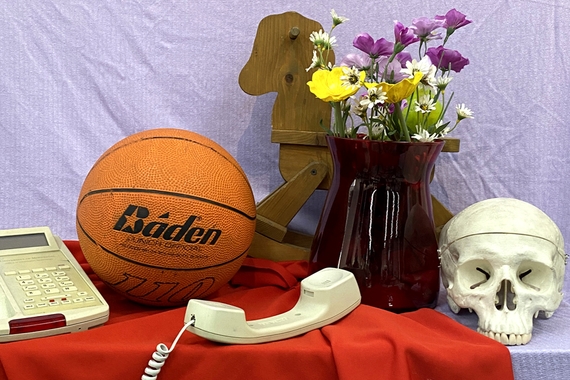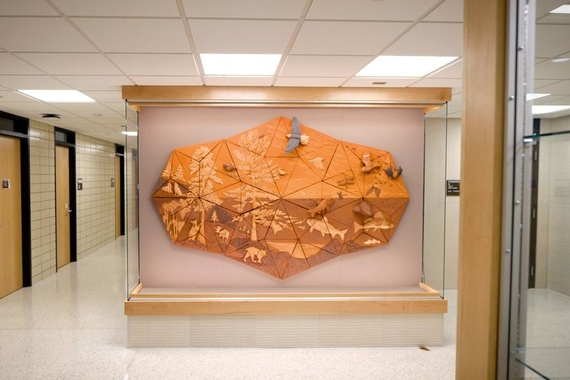Hungry For After: Virtual Exhibition Tour
Hungry For After features the work of seven artists about to complete their Master of Fine Arts degree in the Department of Art here at the University of Minnesota. As the exhibition title suggests, these artists, like so many before them, are eager for what's to come. Their desire speaks to a greater collective want for an end, but at the same time, does not suggest a "return." For these artists, there is no "return to normal" in 2021, but rather a time for letting go, as witnessed through their seven diverse perspectives.
Upon entering the gallery, Caitlin Skaalrud invites ghosts to tell their stories from beyond the grave in their installation entitled, the me behind the closed door. They pieces together the skeleton of a room, where over the years they would conduct paranormal investigations, alone at night. Using comics as a medium for the dead, Skaalrud draws parallels between ghostliness and queerness. They gladly welcome this haunting, taking the time, night after night to occupy this liminal space, to sit in the quote “grayness that shifts like iridescence.”
Across the way from Skaalrud's installation, a collection of text, objects, and photographs, comprise Nicholas Bauch’s System for Embodying Landscape: Mojave. With a background in cultural and historical geography, Bauch provides us with a series of instructions and audio offerings, for communing with the desert landscape. Bauch further activates the space through performance, embodying the scampering movements of a lizard.
In another area of the gallery, Bauch presents a second installation, this time communing with a suburban, corporate landscape. In System for Embodying Landscape: Twin Cities, Bauch plays the role of archivist, partaking in a variety of absurdist tasks. Using photographic slideshows, infographics, and found objects, Bauch catalogues the residue of 31 walks connecting ten fortune five hundred companies, visually documenting what Bauch terms as “suburbiscity.”
In contrast to the site-specific archive of Bauch's installation, Sayge Carroll builds objects and environments that merge the physical and virtual, revealing portals between time and space. Carroll’s installation, Other Worlds, makes use of triads, as found in the repeated use of triangular shapes, the layering of three projection scrims, and the use of musical triads found in jazz, blues, and gospel as seen here in the record collection of Carroll’s father. Through clay and textiles, Carroll creates a physical space for music and meditation, building a world in which past, present, and future generations can share space together.
Moving past Carroll's installation, we encounter objects available for sale or barter as part of Grant McFarland’s Cash and Carry. An endeavor in making, learning, labor, and value, each of the objects seen here has an identical twin, one is placed here in the gallery, and the other in McFarland’s home. Hand-made utilitarian objects such as a bed, stool, and spoon challenge notions of value, utility, and consumption.
Driven by a desire to give form to the unacknowledged, Brandon Chambers creates ceramic sculptures and works on paper that honor the unknowable. The grid, as both a structure for building and a tool for orientation, provides the visual building block of Chambers’s work. The rigidity and reliability of the grid is quickly abandoned, becoming a quote “untrustworthy crutch." In each painting, parts of the grid become eroded, shifting between plumbs of color. These same shapes are reiterated in Chamber’s cephalopod-like forms, conveying a soft-bodied, malleable appearance, that further contradicts its rigid material state.
In Gestures of Pressure and Time, R. C. Tibbott combines clay, processes of repetition, and artifacts from his military service to investigate an object’s potential once it has withstood its intended use. Referencing military postures and rank formations, Tibbott pays special attention to the spatial relationship between each object. Each piece provides a snapshot of Tibbot’s methodical engagement with materials, and how those materials behave under a set of rules.
Resisting hierarchical and linear structures, Rini Keagy’s practice equalizes subjective and archival material to engage with sites of historical and psychosocial trauma. In this particular body of work, Keagy’s still and moving images subvert categorical distinctions, between personal and historical accounts encompassing Guatemala's 36 year-long civil war. Keagy offers a remix of moving images, sound bites, screen printed, and digital images, further reflecting a diasporic experience both in content and form. After watching Keagy's film El Cenote you will certainly be hungry for more.


